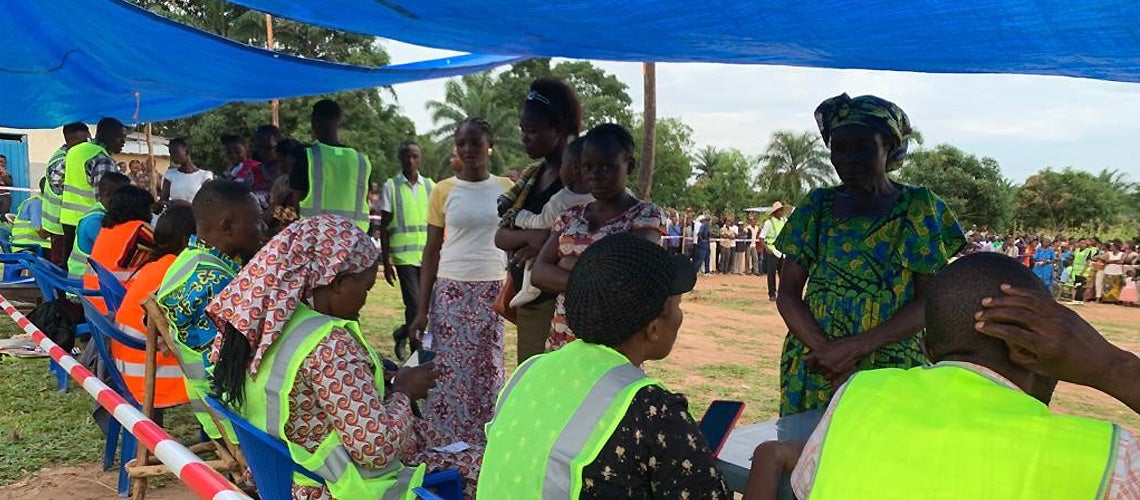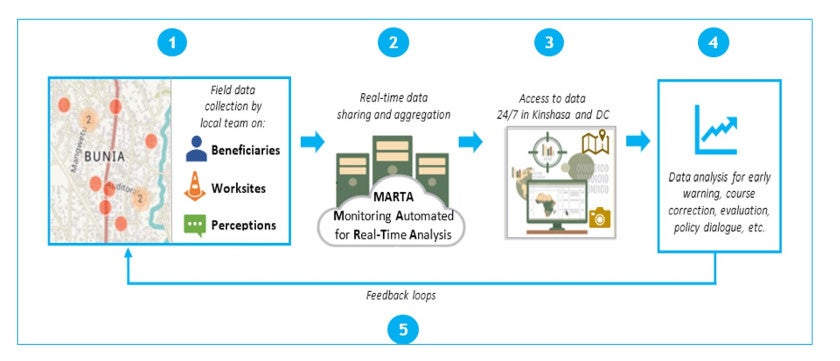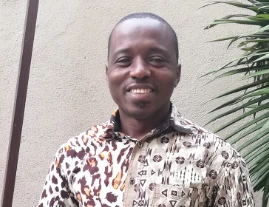 Registration of beneficiaries for public works program in Kananga, DRC. Photo: Sophie Grumelard / World Bank
Registration of beneficiaries for public works program in Kananga, DRC. Photo: Sophie Grumelard / World Bank
The good news first: development actors are not shying away from fragility, conflict and violence (FCV) and their programs are getting more ambitious and challenging. Now, the bad news: access to those in need in FCV is shrinking fast. Rising violence against aid workers has been an obstacle in recent years. The current pandemic – and the associated travel constraints – is a new blow to the ambition of leaving no one behind.
Against this backdrop, the burning question is: Can you really manage an aid project from the distance?
The Monitoring Automated for Real Time Analysis (MARTA) is a practical approach that we developed to tackle the challenge of remote project monitoring during the 2018-2020 Ebola crisis in the Democratic Republic of Congo (DRC). Our premise is that if this approach worked in such a complex emergency setting, it could be useful anywhere.
Ebola in DRC: the perfect storm
For the first time, an Ebola epidemic was developing in a zone of active conflict. The situation got quickly out of control: cases were surging and health responders were under attack. The World Health Organization declared it a Public Health Emergency of International Concern, the highest level of alert.
A factor in the initial failure to curb infections had been communities resisting public health recommendations, often violently. The Ebola response strategy was updated to address communities’ grievances with a large public works program (i.e. jobs and infrastructure) and thereby improving acceptance of medical teams in Ebola hotspots.
Given the stakes and risks in deploying this emergency program, and the lack of physical access to project sites due to the geography, the violence and the epidemic, remote monitoring became paramount. This is when MARTA came to live.
A simple, yet powerful operational nudge
Inspired by the Geo-Enabling Monitoring and Supervision (GEMS) initiative, MARTA leverages the power of mobile data collection tools like KoBoToolBox to create a portfolio of high-frequency surveys. Local students are equipped with smartphones and trained to fill in pre-coded weekly questionnaires about the progress of the works, the well-being of beneficiaries, and the perceptions of communities. Data is then uploaded to a secured server for remote access and analysis.
MARTA was successfully piloted with the support of the State and Peacebuilding Fund, collecting more than 100,000 field surveys, including photos and GPS coordinates during the first year. We continuously crunched these two million data points to monitor implementation in quasi-real time and remotely, tracking key project indicators, spotting developing risks, and documenting results.
Fast to deploy, cost effective, community friendly, and privacy safe, this customized system has been key in the successful implementation of the program in a low capacity, hard to reach, and high-risk environment. We are now scaling up MARTA to monitor the entire World Bank’s social protection portfolio (community infrastructure, cash transfers, and public works) in DRC.

Examples of operational application for all projects
MARTA is a simple data collection approach that can be continuously adapted to respond to different project needs, contexts, or sectors. Here are three practical examples of how MARTA can be used to improve remote project monitoring (and more):
- Beneficiaries management: A short questionnaire, both at the beginning and the end of the program, allows us to identify project beneficiaries, build their socio-economic profile, and eventually evaluate outcomes (household income, mobility, etc.). The automation of MARTA increases data quality, streamlines registration, and limits fraud. Data is also of immediate use for an impact evaluation, for instance on the differentiated impacts on women. This large beneficiary database could also be turned into a social registry to speed up humanitarian intervention against COVID-19.
- Compliance monitoring: High frequency surveys follow on the ground activities in multiple sites and quasi real time to propose timely course correction measures. Special attention can be paid on technical, fiduciary, and safeguards compliance, e.g. use of protective equipment or delivery of procured goods. MARTA allows random spot checks, but also targeted reviews by analyzing outliers in reporting, e.g. a sudden increase in female absenteeism is a red flag. Collecting photos and GPS coordinates can further help document issues and their resolution.
- Early warning mechanism: MARTA complements traditional grievances redress mechanisms with the frequent collection of perception surveys from general community members (taxi drivers, street vendors, etc.) and key informants (teachers, religious leaders, etc.). It is a must to anticipate operational issues, including security, in a high risk and volatile environment. Integrity risks can also be identified via perceptions on staff recruitment or quality of works. MARTA could also quickly be reprogrammed to collect information on the impacts of COVID-19.
Initial lessons learned
MARTA was designed out of necessity and deployed with a learning-by-doing approach. Practical lessons include:
- respect the principle of data minimization to protect beneficiaries’ privacy;
- adjust your data collection system to local capacities, and improve both simultaneously;
- follow a do-no-harm approach to shield local surveyors and respondents;
- mix MARTA with the plenty of other innovations in fragile settings, e.g. social media analytics, bulk SMS surveys, and satellite imagery; and
- make an upfront investment in data analytics to turn data into action.
Remote project monitoring is not the panacea for development aid. However, in the current context, it is an approach that practitioners should want to experiment. MARTA is a starting point.
Do you have other possible applications or adaptations for such an approach to remote project monitoring?




Join the Conversation